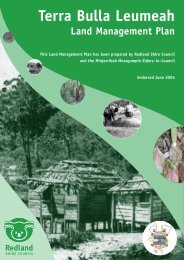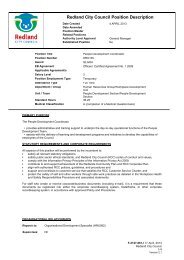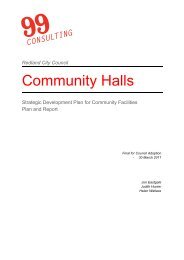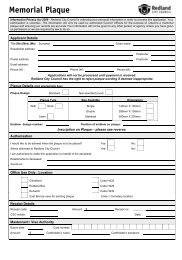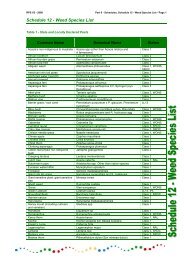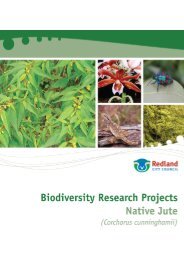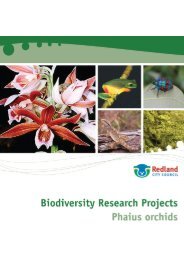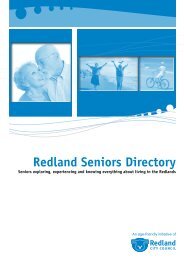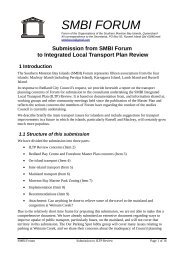Land for Wildlife Newsletter - IndigiScapes
Land for Wildlife Newsletter - IndigiScapes
Land for Wildlife Newsletter - IndigiScapes
Create successful ePaper yourself
Turn your PDF publications into a flip-book with our unique Google optimized e-Paper software.
fauna profile<br />
Snake Sense and Sensibility<br />
Yellow-faced Whip Snakes feed on small<br />
lizards and are potentially dangerous to<br />
humans. Photo by Sarah Bennett.<br />
Although we all try to encourage wildlife<br />
into our backyards, sometimes snakes<br />
are left off our guest list. We don’t need to<br />
be rolling out the red carpet and inviting<br />
them into our homes but with a few tips<br />
and some common sense, we can learn to<br />
live harmoniously with snakes in the areas<br />
around our home.<br />
Snakes are an important part of our<br />
environment but are often misunderstood.<br />
Not every animal that looks like a snake<br />
is a snake. Burrowing skinks and legless<br />
lizards are often mistaken <strong>for</strong> snakes. Like<br />
all native wildlife, snakes are protected<br />
under the Queensland Nature Conservation<br />
Act 1992 and intentionally harming a snake<br />
is an offence under this legislation. Under<br />
this same legislation, snakes can only be<br />
removed from their habitat, including your<br />
home or yard, by trained and authorised<br />
persons.<br />
This time of year is when we generally see<br />
an increase in snake activity. The warmer<br />
weather also finds us humans being<br />
more active and doing more jobs around<br />
the home. Some of these handyman<br />
adventures find us turning over building<br />
materials or moving junk around in the<br />
shed which increases our chances of<br />
uncovering a surprise visitor such as a<br />
snake. It is important to remember that<br />
unless a snake is provoked, it presents little<br />
or no danger to us.<br />
Snakes are particularly fond of hanging<br />
around our houses because there are<br />
more opportunities <strong>for</strong> them here: more<br />
food, more shelter and fewer predators. A<br />
favourite food item of snakes is rats. Rats<br />
also love to hang around our houses to take<br />
opportunity of our compost gardens as<br />
well as excess chook food and bird seed.<br />
A few tips to decrease your chance of<br />
a surprise visit from our slithery friends<br />
around the immediate house area include:<br />
• Maintaining your lawn.<br />
• Locating gardens and sheds away from<br />
the house.<br />
• Ensuring timber, building and rubbish<br />
piles are neatly stacked.<br />
• Placing food scraps in closed compost<br />
bins to avoid attracting rodents to the<br />
yard.<br />
• Making your bird aviaries and chook<br />
sheds rodent and snake-proof.<br />
• Storing bird seed in rodent-proof<br />
containers.<br />
It’s important to remember that not all<br />
snakes are venomous, and not all venomous<br />
snakes are dangerous, with most only<br />
having enough toxin to stun small prey such<br />
as frogs and lizards. However, Australia’s<br />
venomous snakes are some of the most<br />
lethal in the world, and so any snake<br />
bite should be regarded as serious and<br />
immediate first aid should be administered.<br />
Most snake bites occur as a result of trying<br />
to move or kill a snake, so never try to<br />
corner, capture or harm a snake.<br />
If you encounter a snake, stay calm, and<br />
if possible, walk away. Most snakes, even<br />
the venomous ones will retreat if given<br />
the chance. If you have a snake inside your<br />
house the most important thing is to leave<br />
it alone, which gives the snake a chance<br />
to leave on its own. If possible, close all<br />
your internal doors and open the external<br />
doors and keep everyone including pets<br />
away from snake. If this doesn’t work, call<br />
Queensland Parks and <strong>Wildlife</strong> Service on<br />
1300 130 372 <strong>for</strong> contact details of a local<br />
snake catcher who can relocate the snake.<br />
Get more tips on how to live safely with<br />
snakes from the Living with <strong>Wildlife</strong> section<br />
of the Department of Environment and<br />
Heritage Protection website or http://<br />
tinyurl.com/bykacpe<br />
The recommended first aid <strong>for</strong> Australian<br />
snake bites is:<br />
ü Keep the patient very still and calm - the<br />
more agitated and mobile the patient<br />
is, the more the toxin will flow through<br />
their body.<br />
ü Call an ambulance, ring 000.<br />
û DO NOT cut, clean or wash the wound.<br />
ü Immediately apply a broad, elastic<br />
bandage to the bite area. If you do<br />
not have a bandage, torn clothing or<br />
stockings will do the job if nothing else<br />
is available.<br />
û DO NOT apply a tourniquet or disrupt<br />
blood flow to the limb.<br />
ü Bind the entire limb with even pressure<br />
and bandage thickness (e.g. from the<br />
bite area, down to the fingertips and<br />
back up to the armpit or from the bite<br />
area, down to the toes and back up to<br />
the groin).<br />
ü Immobilise the limb with a splint - any<br />
fairly straight, hard material can be used<br />
(e.g. a broom handle, a tree branch<br />
etc) this splint needs to be loosely<br />
bandaged on.<br />
ü Mark the bite area on the outside of the<br />
bandage.<br />
ü For bites on the body or face, maintain<br />
firm pressure over the bite area as the<br />
above ‘immobilisation’ method cannot<br />
be applied to these areas.<br />
û DO NOT attempt to kill or catch the snake.<br />
ü Take the patient immediately to medical<br />
aid.<br />
Coastal Taipans are considered<br />
Australia’s most dangerous snake and<br />
can become aggressive if cornered or<br />
harassed. Their preferred prey is rats.<br />
Article by Rebecca Condon<br />
<strong>Land</strong> <strong>for</strong> <strong>Wildlife</strong> Officer<br />
Logan City Council<br />
<strong>Land</strong> <strong>for</strong> <strong>Wildlife</strong> South East Queensland January 2013 7



